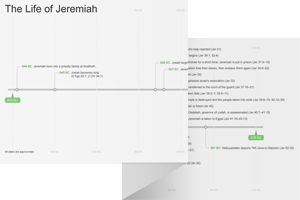39:1–18 Jerusalem falls to Babylon, and Zedekiah is taken captive. Apart from the details about the treatment of Jeremiah and a prophecy (vv. 11–18), the narrative closely parallels the accounts in 52:4–16 and 2 Kgs 25:1–12. |
39:1 the ninth year of Zedekiah Probably 587 bc. The full date of the beginning of the siege is given in 2 Kgs 25:1 and Ezek 24:1; it was the 10th day of the 10th month. See note on Ezek 24:1.
 Israelite Calendar Table
Israelite Calendar Table
Zedekiah, the king of Judah See note on Jer 21:1.
Nebuchadnezzar the king of Babylon See note on 21:2.
39:2 the eleventh year of Zedekiah, in the fourth month The siege lasted about a year and a half, until July of 586 bc.
39:3 the Middle Gate The gate is mentioned only here, but archaeological evidence suggests it was the north-facing gate, perhaps the same as the Fish Gate mentioned in Neh 3:3. Sitting in the gate asserted Babylonian rule over the city.
Nergal-sharezer, Samgar-nebo The list of names presented in this verse can be construed as the names or titles of six officials, or as the names and titles of three officials. The Hebrew scribes preserving the ot text had difficulty distinguishing names from titles and properly dividing the Babylonian syllables. The names and titles appear differently in various English translations, and their meanings are unclear.
39:4 went out at night from the city See 2 Kgs 25:4 and note on Ezek 12:4.
toward the Jordan Valley The wilderness east of Jerusalem around the Dead Sea. See note on Jer 17:6.
39:5 the plains of Jericho The area just east of Jerusalem. Zedekiah didn’t get very far.
at Riblah in the land of Hamath The city in northern Syria where Nebuchadnezzar was headquartered during his campaign in Palestine. Compare Ezek 6:14.
39:6 the king of Babylon slaughtered the sons of Zedekiah See 2 Kgs 25:7.
39:7 he blinded the eyes of Zedekiah Compare Ezek 12:13 and note.
39:9 Nebuzaradan, the captain of The commander of the forces that conquered Jerusalem. He is also responsible for the destruction and plunder of the city and the organization of the captives for exile.
of the forces that conquered Jerusalem. He is also responsible for the destruction and plunder of the city and the organization of the captives for exile.
39:10 poor people, who had nothing The poor people were not deported; since they had no property, they posed no threat to Babylon. Giving fields and vineyards to the poor was a means of developing a positive relationship with them and restoring agriculture in the region.
39:12 set your eyes on him Nebuchadnezzar might have been aware of Jeremiah’s pro-Babylonian sympathies through Judaean deserters (see Jer 37:19).
39:13 Nebushazban the chief officer See note on v. 3. One of the three officials named here is the same one mentioned in v. 3. Here, the Rab-saris is either a different individual than the Rab-saris in v. 3 or is identified with a different name.
39:14 Gedaliah The governor of Judah after the Babylonian exile.
Gedaliah’s name means “Yahweh is great.” His introduction with a double patronym (listing the names of both his father and grandfather) in v. 14 clarifies his association with the prominent family of royal scribes descended from Shaphan (see 2 Kgs 22). Several members of this family are depicted as offering support for Jeremiah (see Jer 26:24; 36:10, 25). After the destruction of Jerusalem and the exile of most of the population to Babylon, Gedaliah was appointed governor over the remaining population of poor farmers. He resided at Mizpah (modern Tell en-Nasbeh), about eight miles north of Jerusalem. Some of the remaining Jewish soldiers who had escaped capture supported him (40:7–10). He assured them that Judah was now a Babylonian province, and they were free to return to a safe and peaceful agricultural lifestyle if they accepted Babylonian rule. His governorship ended when he was assassinated by Ishmael son of Nethaniah (41:2–3). Jeremiah is taken to Egypt with the group that flees after this assassination because they fear Babylonian reprisals for the death of the governor. |
39:16 Ebed-melech the Cushite See 38:7 and note.
39:17 I will rescue you on that day Ebed-melech (also rendered “Ebed-Melek”) will be spared because of his support for Jeremiah and devotion to Yahweh.

|
About Faithlife Study BibleFaithlife Study Bible (FSB) is your guide to the ancient world of the Old and New Testaments, with study notes and articles that draw from a wide range of academic research. FSB helps you learn how to think about interpretation methods and issues so that you can gain a deeper understanding of the text. |
| Copyright |
Copyright 2012 Logos Bible Software. |
| Support Info | fsb |
 Loading…
Loading…



 Gedaliah
Gedaliah